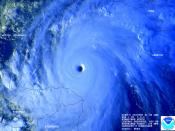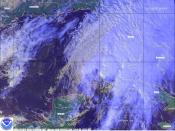Hurricane Mitch developed in the Caribbean Sea in October 1998 and became one of the strongest and deadliest Atlantic hurricanes ever recorded. Some of the details of the hurricane and its effects are summarised below.
Most hurricanes which develop in the Atlantic Ocean originate from small disturbances in the weather over western Africa (known as tropical waves) which move westwards across the Atlantic Ocean. A tropical depression forms when the cloud mass associated with a tropical wave starts to grow and rotate in an anti-clockwise direction. Mitch followed this pattern - originating as a tropical wave and eventually forming into a tropical depression when in the southern Caribbean Sea just north of Colombia.
Here is the life cycle of Mitch:-
22 October: Tropical Depression `Thirteen' forms (winds less than 39 mph), but by the end of the day is upgraded to Tropical Storm Mitch (winds greater than 39 mph) and starts moving northwards.
24 October: Mitch is upgraded to a hurricane (winds greater than 74 mph).
25 October: Hurricane Mitch turns towards the west.
26 October: Winds near the centre of the hurricane peak at 180 mph.
27 October: Mitch starts to weaken, but turns southwards towards the northern coast of Honduras.
29 October: Mitch is downgraded to a tropical storm and makes landfall over Honduras.
31 October: Mitch is downgraded to a tropical depression whilst moving slowly south-westwards and still producing heavy rain.
01 November: Mitch dissipates as a depression over Guatemala.
03 November: The remnants of Mitch have moved northwards and reform as a tropical storm in the southern Gulf of Mexico.
05 November: Mitch makes landfall on the Gulf coast of southern Florida.
06 November: Mitch is declared `extra-tropical' as it heads north-eastwards across the Atlantic.
After becoming an `extra-tropical' storm Mitch raced across the Atlantic and...


